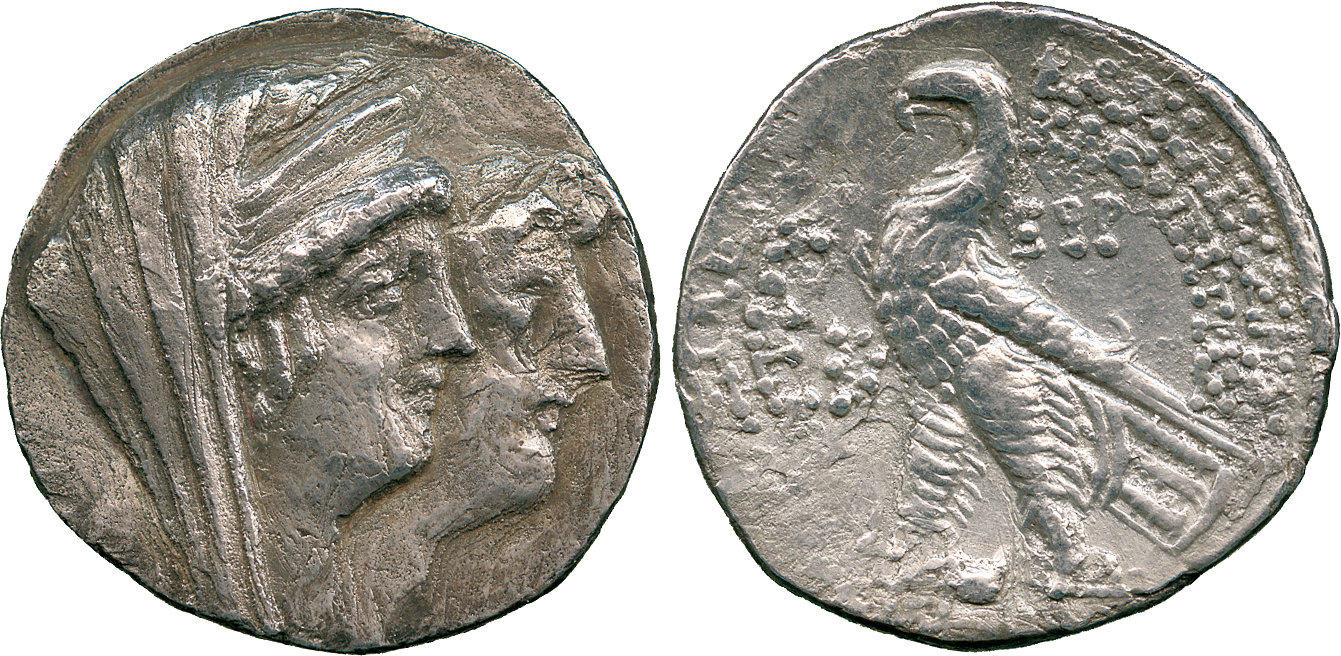Ptolemais-Ake (Cleopatra thea and Antiochus VIII), silver, tetradrachms (eagle) (125-120 BCE)
From SILVER
125 BCE - 120 BCE Silver 1,383 kg
Description
| ObverseInscription or printing placed on the obverse.: | Jugate busts of Cleopatra Thea, diademed and veiled, wearing stephane, and Antiochos VIII, diademed, facing right |
| ReverseInscription or printing placed on the reverse.: | BAΣIΛIΣΣHΣ KΛEOΠATAPAΣ / BAΣIΛEΩΣ ANTIOXOY (Greek).Eagle standing left on a thunderbolt, monogram on left, date on right |
Mint and issuing power
| MintIdentifies the place of manufacture or issue of a numismatic object.: | Ptolemais-Ake | Ancient regionAncient region.: | Phoenicia | Modern countryModern country: Israel | AuthorityIdentifies the issuing power. The authority can be "pretended" when the name or the portrait of X is on the coin but he/she was not the issuing power. It can also be "uncertain" when there is no mention of X on the coin but he/she was the issuing power according to the historical sources: | Antiochus VIII Grypus (Seleucid king, 121/0-97/6 BC), Cleopatra Thea (Seleucid queen, 150-121 BC), Seleucid Dynasty (312-63 BC) |
Chronology
| FromIdentifies the initial date in a range assigned in a numismatic context. | 125 BCE | toIdentifies the final date in a range assigned in a numismatic context.. | 120 BCE | PeriodTime period of the numismatic object.: Hellenistic 323-30 BC |
Physical description
| MetalThe physical material (usually metal) from which an object is made.: | Silver |
Median weightMedian of the weights of numismatic objects (in grams). in grams | 14.00 | DenominationTerm indicating the value of a numismatic object. Examples: tetradrachm, chalkous, denarius.: | tetradrachm |
StandardStandard.: | Ptolemaic |
Image

S2021 Ptolemais Cleopatra thea antiochus eagle.jpg [1]
References
| Die study referencePublication of the study: | Voulgaridis 20001Voulgaridis 2000, p. 181-182 | ||
| Coin series referenceReference to coin series study: | SC II2SC II, n° 2272, HGC 93HGC 9, n° 1182 | ||
Obverse dies distribution
| FrequencyFrequency of specimen in distribution. ᵖ | Number of obversesNumber of obverse dies. ᵖ (o) | % (o) | Number of coinsNumber of coins. (n) | % (n) | Die nameName(s) of the die(s). |
| 1 | 2 | 50 | 2 | 15.38 | 1, 2 |
| 5 | 1 | 25 | 5 | 38.46 | 4 |
| 6 | 1 | 25 | 6 | 46.15 | 3 |
| Total | 4 of 4 | 100 | 13 of 13 | 99.99 |
Reverse dies distribution
no distribution is available
Quantification
| Number of obversesNumber of obverse dies. ᵖ (o) | 4 | Number of singletons (o1)The number of singleton coins. ᵖ | 2 |
| Number of reverse diesNumber of reverse dies. (r) | 10 | Number of coinsNumber of coins. (n) | 13 |
| Coins per obverse dieNumber of coins per obverse die. (n/o) | 3.25 | Coins per reverse dieNumber of coins per reverse die. (n/r) | 1.3 |
| Reverse per obverse ratioRatio of obverse dies divided by reverse dies. (r/o) | 2.5 | Percentage of singletons (o1)number of coins (n) divided by the number of singletons (o1) ᵖ | 50 % |
| Original number of dies (O) (Carter 1983 formula)The estimation of the number of coins according to Carter 1983 ᵖ | 4.94 | Coins struck if 20,000 as average productivity per dieCoins made if the average productivity for obverses (according to Carter) is 20,000. ᵖ | 98,800 |
| Original number of dies (O) (Esty 2011 formula)The estimation of the number of coins according to the singleton formula in Esty 2011 ᵖ (O) | 5.78 | Survival rate if 20,000 as average productivity per dieSurvival rate if average productivity is 20,000. ᵖ | 0.00013 |
| Coverage (o = % of O) (Esty 1984 formula)Esty 1984 - coverage (% of O) ᵖ (o = % of O) | 84.62% | Die productivity if survival rate 1/2,000Average productivity if survival rate is 1/2,000. ᵖ | 5,263.16 |
| Weight of silver (in kg) if 20,000 coins per die (O = Carter formula)Carter 1983 * Median weight * 20000 (*10 if gold or electrum) ᵖ | 1,383 kg <br /> 1,383 kg | Die productivity if survival rate 1/5,000Average productivity if survival rate is 1/5,000. ᵖ | 13,157.89 |
Remarks
Most likely one single workstation